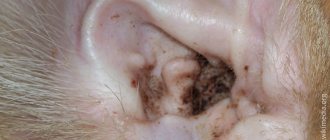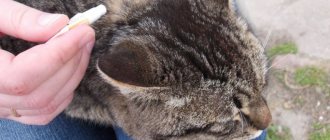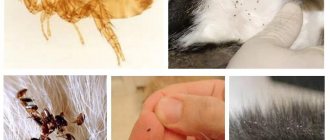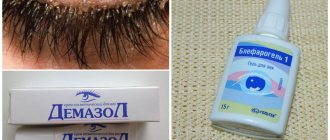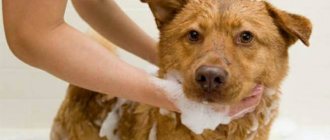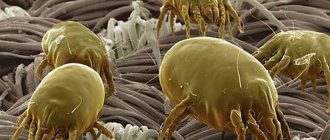If your indoor cat is clearly bothered by his ears, the most likely cause of the discomfort may be otodectosis, which is caused by mites. In this case, the pet requires immediate help. Infection with ear parasites dramatically reduces the quality of life of an animal and can even lead to its death. You will learn how to identify the symptoms of the disease and what medications to successfully treat it from our article.
What mites look like in cats' ears, photo
You can get an idea of what ear mites look like in cats from common photos and descriptions of the parasite. Therefore, if the first similar symptoms appear, the animal should be carefully examined. It is advisable to take him to a veterinarian who can make an accurate diagnosis.
It is also quite possible to detect a bug on your own. It has an oval body of microscopic size (up to 0.6 mm) of a yellowish tint, 8 limbs and 2 pedipalps. In most cases, the parasite is found in the animal's ear folds.
This is interesting: ear mites are very tenacious. While waiting for its prey, it can go without food for just over two months. And if he does not find a “carrier” during this time, he will die.
Routes of infection
Otodectosis does not live long in the external environment - a maximum of 3 weeks at a temperature of +10-20°C. If the thermometer drops below -5°C, the insect will survive for 3-5 hours.
But the likelihood of becoming infected with Otodectes cynotis is high. Otodectosis is transmitted through contact and household contact:
- when interacting with an affected animal;
- through care items - beds, combs, bowls;
- from clothes and shoes if the owner stroked another sick pet;
- from mother to puppies.
Dogs are more likely to get ear scabies in early spring and late fall. But you can get infected in winter or summer. Because The parasite lives on the body of pets, its activity does not depend on climatic conditions.
What animals are at risk?
All dogs get otodectosis. But more often ear mites parasitize puppies and juniors for 1.5-6 months.
The risk of infection is higher in breeds with long ears - dachshunds, beagles, basset hounds, spaniels. A closed channel and long hair lead to the accumulation of secretions and dirt, creating an ideal environment for parasites.
Most often, ear mites are picked up by hunting dogs - they become infected from wild animals.
Otodectosis occurs in other pets. Therefore, if cats or ferrets live in the same house with a sick dog, they are isolated.
Symptoms of otodectosis
To determine whether a pet has been infected with a parasite, it is necessary to conduct a full diagnosis of its behavior and condition as a whole.
The first signs of otodectosis are:
- Anxiety. Due to the incessant itching, the cat may begin to behave aggressively.
- Scabies. The animal tries to ease the discomfort. It will rub against hard surfaces, shake its head, or scratch its ear with its paw. The danger is that as a result, scratches form on the inside of the ear. Subsequently, they become infected and begin to fester. This should not be allowed, because it can lead to the death of the pet.
- Swelling. Associated with a large accumulation of blood in the areas affected by the tick.
- Exudate - liquid discharge on damaged areas. Subsequently, mixing with particles of the epidermis and waste products of the insect, they transform into brown scabs. Often accompanied by otitis media.
- Lethargy of the animal associated with an increase in body temperature.
- A crust in the area of the ear canal, resulting in the formation of plugs of dried sulfur.
- Fur glued together with pus.
- A specific unpleasant odor that can spread to the affected area.
- Hearing impairment in later stages.
- "Bowheadedness." The cat constantly turns its head 120 degrees so that the affected ear is located below.
Important: if you find that your pet periodically has nervous attacks, contact a specialist immediately. In this case, there is a high probability that the pathogen will penetrate into the inner ear and begin the process of inflammation of the meninges.
Why is otodectosis dangerous?
In most cases, two ears are affected at once. The possibility of infection increases during warm and humid periods of the year. Small kittens and weak pets are at risk. Interestingly, it can take a year from the moment of infection to the appearance of the first signs. The disease will become noticeable when a bacterial infection is attached to it. The furry friend will constantly experience discomfort, will not eat, sleep, and will start shaking his head.
The ear will scratch due to unbearable itching. This damages the capillaries and leads to the appearance of large hematomas. In the area where the skin has been damaged, infection in the form of bacteria or fungi penetrates. The inflammatory process starts, tissue swelling, redness, and pus appear.
If the inflammation is not stopped, it will spread to the eardrum, and this can lead to weakening or loss of hearing. At this time, your furry friend will behave irritably, nervously, even aggressively. Over time, inflammation can reach the head. The prognosis in these cases will be disappointing - the pet may die from the tumor.
It is important to avoid complications. If you notice deviations similar to the symptoms of otodectosis, contact a professional doctor immediately.
How to treat ear mites in cats: effective drugs
There are many effective drugs for treating ear mites in cats, including both store-bought medications and folk remedies.
Injections
A radical method of eliminating the problem, which only a veterinarian has the right to prescribe. Injectable preparations are highly toxic. They can cause side effects such as allergies, itching, and hair loss. The advantage of this procedure is the extermination of all types of parasites on the pet’s skin. For example, Doramectin (Dectomax, Doramek), Otodectin are used.
Ointments
Ointments based on acaricides help cope with the disease.
The following have proven themselves to be good:
- Amidel-gel. Not suitable for treating the inflamed area in animals at the recovery stage, kittens under 2 months of age. The composition includes: acaricide, analgesic, antimicrobial component, wound healing substances.
- Aversectin ointment. It is not recommended to treat the ears of animals with individual intolerance to the active ingredient - Aversectin, kittens, pregnant and lactating, and convalescent “patients”. Requires additional use of Perhydrol or specialized lotions to remove “crusts” from the ear.
- Ivermec-gel. Contraindicated for breeds sensitive to the active substance, as well as convalescent and depleted representatives of the cat family. Contains an analgesic - lidocaine hydrochloride. Additionally, it has a wound-healing effect.
To achieve the result, you need to clean the animal’s ears, apply the drug to the affected area, fold the auricle in half and do a light massage.
Caution: when using internal medications (drops), you must strictly follow the dosage indicated in the instructions. Otherwise, the poisons, having accumulated, will poison not only the parasites, but also the animal itself.
Drops
One of the most effective and simple methods of dealing with ticks is the use of drops. Their range is distinguished by a fairly wide range of drugs, which allows you to choose the most suitable one for both the kitten and the “mother” during lactation.
The rating of highly effective ear drops includes:
- Surolan. Not recommended for use when the drum membrane is perforated. Contains antimicrobial and antimycotic complexes. Has an anti-inflammatory effect. The frequency of instillation is once every 2 weeks.
- Aurikan. The main substance is the insecto-acaricide Diazinon, which also contains an antiseptic and analgesic. The drug additionally helps to minimize the inflammatory process. For the first week, the auricle is treated daily, then every 3 days.
- Amitrazine. A drug based on a composition of acaricides Amitraz and Dimexide. Repeated treatment is carried out a week after the first procedure.
- Ectodes. Requires preliminary cleaning of the ear canal. This drug is based on propolis and sulfur. Among the contraindications: lactation period, age up to 1 month, violation of the integrity of the tympanic membrane. Frequency of use: every 5-7 days.
- Anandin "+". Consists of Permethrin, Gramicidin and the immunostimulant Anandin. Hearing therapy lasts up to 7 days. If you miss at least one day, treatment starts again.
- Amit. Designed for soaking crusts using a cotton pad twice a day. Course duration is up to 5 days. Contains Prednisolone and Amitraz. If a secondary infection occurs, the product should be replaced. Not recommended for kittens under 2 months, cats during lactation, and mated animals.
- Decta. Contraindications are standard. Frequency of use: once every 3-5 days. Consists of Amitraz, Dexamethasone. Supplemented with propolis.
- Dana. Drops are presented in the form of pipettes. The active ingredient is Diazinon. After the procedure, a light massage is recommended. Requires repetition of actions after a week.
- Mycodemocid. The product contains isopropyl alcohol detergent, sea buckthorn oil, chlorophos. If necessary, the treatment is repeated after 7-8 days.
Sprays
An important advantage of sprays is ease of use. In addition to your pet's fur, you can additionally treat the animal's bedding with the drug. This is done to prevent re-infection.
Among the common products of this type, Ivermec spray is widely in demand. It is recommended to spray it in the ear area a couple of times a day at intervals of 3-5 days.
Advice: you can prevent animals from licking any medicinal composition by wearing an “Elizabethan” collar (veterinary cone) before it dries.
Treatment of a kitten and a pregnant cat
You should choose drugs for the treatment of otodectosis in very young kittens and pregnant cats more carefully. Folk remedies can be called completely safe, but they can only help with mild, non-advanced forms of the disease. When studying the range of industrial drugs, you should choose those that are not absorbed into the blood.
The drug Stronghold, which is applied once, is approved for use in pregnant cats. It is low-toxic and, subject to dosage, absolutely safe. It is approved for use in kittens from 6 weeks of age. For babies, you should choose drops in lilac-colored packaging, and for adults, blue ones.
Another safe remedy for the treatment of ear scabies in pregnant and lactating females is the drug Frontline Spot On. It does not enter the animal’s blood, but is distributed in the epidermis and sebaceous glands. For kittens from the first days of life you can use Frontline Spray.
You should carefully choose medications for the treatment of ear scabies in kittens - some of them can harm your furry baby
Folk remedies for black plaque
It is not always possible to use purchased medications at the first stage of tick infestation. In this case, you can use home remedies. They are allowed in the absence of severe mechanical damage from claws, coagulated blood and blackness.
Mineral oil
An excellent tool that allows you to exterminate the parasite and dissolve the dense crust that has formed. To achieve the goal, you need to use enough product so that it evenly covers the inner ear. Oil therapy lasts 2-3 weeks, on the 5th day the ticks should leave their hiding places.
White vinegar
Dilute the product in equal proportions with water. Place a few drops of vinegar in each ear. At the end of the procedure, the inner surface should be wiped with a cotton pad. Do not use the product on cats that have wounds on their skin.
Development of the disease
Since the tick feeds on tissue fluid and lymph, in order to get food for itself, it injures the upper layer of the epidermis of the external auditory canal with its chelicerae.
The release of tissue fluid in large quantities leads to the formation of a large number of crusts and scabs, and when microtraumas are contaminated with bacteria, a local inflammatory process (otitis externa) occurs.
In advanced cases, a perforation (rupture) of the eardrum , then the inflammation spreads first to the middle ear (otitis media) and to the membranes of the brain (meningitis), which often ends in death.
Up
Rules for cleaning ears at home
Before carrying out the procedure, be sure to clean your cat's ears. This must be done regardless of the drug used, even if there is no such indication in the instructions for it.
As tools you will need:
- cotton pads to remove plaque;
- cotton swabs (it is not recommended to use homemade devices in the form of cotton wool wound around a match, this can cause damage if you are careless);
- cleaning agents (chlorhexidine, hydrogen peroxide, boric acid solution at a concentration of 3%).
Advice: if your pet is not accustomed to this kind of event or has an intractable character, arm yourself with a towel or sheet in which to swaddle the animal.
The sequence of the procedure for cleaning a pet's ears:
- Place the cat on your lap after covering it with a blanket. Calm down. Remember that for the animal, your desire to cure it is still perceived as a stressful situation.
- Gently bend the auricle and wipe the surface from dirt.
- Gently clean the affected area with a cotton swab soaked in a disinfectant solution. Never pick an animal's ear with pressure.
- Apply the drug. Massage lightly.
- Give the cat a chance to shake its head. Afterwards, wipe the inside of the ear and the hair around it with the same composition.
Diagnostics
The first suspicions may arise from an observant owner. It is enough to carefully monitor your pet’s behavior and examine its ears. Itching, scratching the ears with paws, and the presence of brown plaque inside the ear canals indicate infection.
Examination by a veterinarian
Before going to the veterinary clinic, the cat’s ears are not cleaned. The accumulated contents will be needed for analysis.
In a clinical setting, the doctor examines the affected area with an otoscope. The instrument allows you to assess the condition of the inner and middle ear, eardrum. Ear discharge is taken for examination under a microscope, after which an accurate diagnosis is made.
Prevention
The appearance of ticks is a case more typical for “walking” animals. However, even if your pet has never left the walls of the house, this does not guarantee that you will not encounter the disease. The reason may be the use of other people's carriers, bedding or toys.
Preventive measures include:
- regular ear cleaning (Bars Lotion, Otifri, Otodepin are excellent);
- preventing contact with stray animals;
- periodic disinfection of paraphernalia (beds, bowls, etc.);
- strengthening the immune system (it is recommended to include foods high in microelements and vitamins);
- the use of special drugs during the period of parasite activity.
Give your furry friends more attention, which is expressed not only in affection and feeding. Do not forget that they, like any living organism, require care. After all, when the animal receives it at the proper level and is in a calm state, then the owner is happy. Good luck!
FAQ
How to prepare a dog's ear for treatment?
It is necessary to clear the auditory approach, as described above.
Can a person become infected with ear mites?
No, ear mites are contagious to dogs, cats, ferrets and wild canines.
How are ear mites transmitted?
Transmitted by contact with an infected animal.
What products for hygienic ear cleaning?
Special lotions (Bars, Excel, Otifri and others). Home remedies (chlorhexidine 0.5%, hydrogen peroxide).
When to clean your ears
Cleaning is divided into preventive and therapeutic.
For preventive purposes, cleaning is carried out every 2–4 weeks, depending on the breed, as well as the body of a particular animal. The large ears of Maine Coon, Savannah, Cornish Rex, Abyssinian, Oriental, Somali, Siamese cats, Devon Rex, elves, and Sphynx cats get dirty faster.
Sulfur is especially actively secreted in breeds without hair inside the hearing organ, since the hairs protect against pollution.
It is difficult to clean the ears of the Scottish Fold on your own, so it is recommended to clean them once every two weeks. A small amount of secretion protects your pet from disease, so there is no need to clean it more often.
Therapeutic cleaning of a Scottish or British cat is carried out before treatment against ticks, the use of antibiotics or antifungal drugs. Before each use of drops or rinses, the sink should be cleaned with saline solution or lotion. Parasites and bacteria produce their own byproducts that interfere with the action of medications. Cleaning is prescribed by a veterinarian and is carried out until complete recovery.
Healthy clean ears of a British cat
